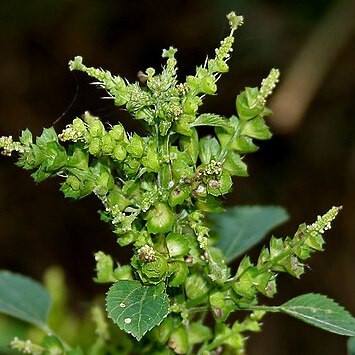Inflorescences up to 3 cm long, spicate, axillary, often paired, male in the upper half, female in the lower, sometimes terminated by a solitary allomorphic female flower; male bracts minute; female bracts accrescent to up to 6 × 10 mm, transversely ovate, multifid-laciniate, the teeth up to 4 mm long, linear to filiform, separate, erect, ciliate, the bracts as a whole sparingly pubescent or ± glabrous, ribbed, 1-flowered.
Leaf blades 2–10 × 1–5.5 cm, ovate, elliptic-ovate or ovate-lanceolate, caudate-acuminate at the apex, crenate-serrate, cuneate or rounded at the base, membranous, subglabrous or sparingly pubescent on both surfaces, and more evenly so along the midrib and main nerves beneath, 3–5-nerved from the base; lateral nerves in 4–6 pairs.
Female flowers sessile; sepals 3, 1 mm long, ovate-lanceolate, ciliate; ovary 0.3 mm in diameter, somewhat 3-lobed, sparingly pubescent above; styles 2 mm long, ± free, laciniate, white. Allomorphic female flowers obovoid, rugulose, with or without a pair of fimbriate whorls near the top, pubescent.
A slender herb. It grows 1 m tall. The leaves are arranged singly. They are on long stalks. The leaves are 3-8 cm long by 2-4 cm wide. The flowers are above small leafy bracts. The flower stalks have separate male and female flowers. The fruit have 3 lobes.
Herb, up to 1.3 m high. Leaves ovate, lamina up to 100 x 55 mm, acuminate, puberulous. Teeth of female bract linear to filiform, separate and erect. Flowers green.
Male flowers subsessile; buds minute, tetragonal, granular-tuberculate, greenish; anthers yellow.
Seeds 1.3 × 1 mm, ovoid, ± smooth, brown, shiny, with a flattened, elliptic caruncle.
An erect, slightly pubescent branched annual, to 21/2 ft. high.
An erect, slender, unbranched annual herb up to 1.3 m tall.
Fruits 1.5 × 2.5 mm, 3-lobed, smooth, subglabrous.
Stipules 1 mm long, narrowly lanceolate, ciliate.
Petioles up to 7 cm long.
Stems puberulous.

